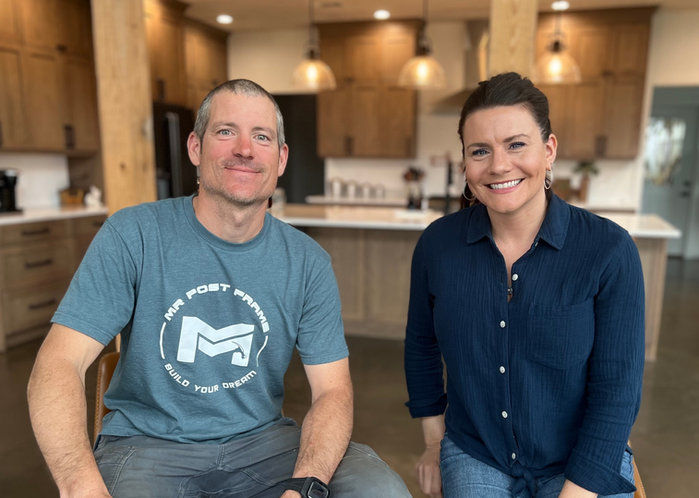Building a Shouse | Column Prep + Wall Framing | Part 2
- MR Post Frame

- Nov 3, 2023
- 3 min read
Updated: Dec 19, 2023
In this part, we will be going through preparing our columns. This will include notching them for our trusses, creating a template to mark all of our columns the same for our girt locations, and squaring up our walls for installing headers.
Locate Highest Footing:

We're out here at a 60 by 80 "shouse" build. We poured these footings last week. Step one is to locate the highest footing. Once I find the highest one, I'm going to zero my laser out on that. Then, I'll go around and mark all of the other footings, noting how much I need to add to my post.
Alright, so I've located my highest one. I'll mark that as zero. Then, I'll go around to all these other ones and write on the bracket how much I need to add to the post. Since I found the highest one, every other one is lower, which means I'm going to have to add some kind of dimension to the length of that post to bring it up. I find that's the easiest for me—zero out the highest one, and then I know all the other ones are going to need added.
Column Template:
Grade boards are usually 11 and a quarter. It's plain and safe. We have two inches of insulation that'll sit over the top of the concrete footing, and then five inches of concrete, so that brings us up to seven. That's our finished floor, and that's where your bottom trim starts. Your bottom trim is one inch, your wainscot starts from there, which is 36 inches. That would be the center, so you have plenty of room for your trim on the bottom and your trim on the top, if that makes sense.

Now that we got that, let's mark some of these out first. We measure out each thing that needs marked. We then go through and see where 14 feet lands. We make our guide and then we can go through and cut and notch all of our columns correctly.
Squaring Columns for Shouse:

We're ready to start to lay out the wall. So, we got all our columns cut, notched, and marked. For our first section, we just have two by sixes roughly laying out there. Now we need to square all of these columns. When we poured the concrete, I drew lines in the concrete for brackets, and we have one garage door opening. I want to set the brackets for the garage door opening, so I'm going to measure. I know it's 40 feet to one opening and 56 to the other. So we're going to measure that out, get it marked, get the brackets put in, and then we'll start squaring up these columns.
Garage Door Opening:
For the garage door opening, we are creating a kind of drive-in, drive-out bay for them. So when we go to dry-set the columns across, we're going to measure out and match them exactly to the measurement of the first two columns so that they are the same. So we'll get the brackets fastened with a screw. We just need everything lined up with the back edge. Once the columns are measured out and in place, I put a header at the top to hold them where they are.
Squaring Opposite Wall:

So once we have one entire side all framed out, its ready to be lifted. But before we lift it, I like to square the other side with the current one. This helps makes sure everything on both sides is even and symmetrical. The opposite side has three 16-foot garage doors, which can be problematic because there stub columns above some. So the way I'm choosing to tackle this is using the farmed wall across. I took a measurement from my corner to my first column, and I'm going to match that over on the other side. That way, I'll start with this column, square. That way, I can stay square, and I know that my truss is going to be in perfect alignment with the other side. So now we got those marked out. We can drill our holes, put the brackets in, square this door opening, and then work off of that.
The next part is going to include raising these walls, deciding what we're going to lift first, how we fasten them down, how we plumb them up, and then how we build our end wall to go up in between these.
Thank you,
MR Post Frame

Patreon Group:
Interested in tackling your build on your own? If you want to explore the possibility of being your GC or self-building, our Patreon membership is for you! It's a community of like-minded people offering support, discounts, Q/A, and more.





Comments